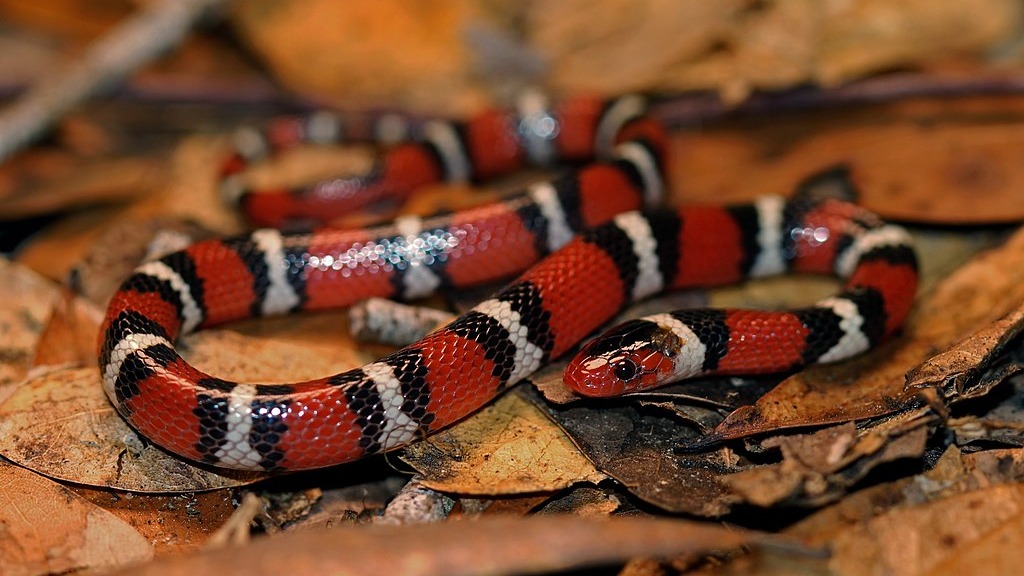So, you’ve probably heard about king snakes before, right? They’re these sleek, powerful reptiles known for their unique ability to eat other snakes.
But here’s a burning question that has probably crossed your mind: do king snakes bite us humans? Well, let’s get down to the nitty-gritty and find out if these fascinating creatures pose any threat to us.
Understanding King Snakes
Physical characteristics of king snakes
King snakes are non-venomous snakes that are known for their vibrant and beautiful appearance.
They have smooth, glossy scales that come in a wide range of colors and patterns, including black, yellow, red, and white.
These patterns often resemble the coloration of coral snakes, which acts as a defense mechanism to deter predators.
These snakes typically grow to be about three to six feet long, although some subspecies, like the California king snake, can reach lengths of up to seven feet.
King snakes have muscular bodies and are known for their impressive strength and agility.
They have a relatively slender head, round eyes, and a forked tongue that they use for smelling and gathering information about their surroundings.

Common types of king snakes
There are several different types of king snakes, each with its own unique characteristics and habitat preferences.
Some of the most common types include California king snakes, speckled king snakes, Florida king snakes, and milk snakes.
These subspecies vary in terms of their colors, patterns, and geographic range. For example,
California king snakes are known for their black and white bands, while Florida king snakes often have vibrant red and black patterns.
Despite their geographic differences, all king snakes share similar behavioral traits and feeding habits.
They are constrictor snakes, meaning that they kill their prey by coiling their bodies and squeezing tight.
King snakes primarily feed on rodents, lizards, and other small reptiles, making them beneficial to have in areas where these pests are a concern.
Habitat and behavior of king snakes
King snakes can be found in a variety of habitats throughout North and Central America, including forests, grasslands, deserts, and even urban areas.
They are adaptable creatures and can thrive in different environments as long as they have access to food and shelter.
One interesting behavior exhibited by king snakes is their habit of eating other snakes, including venomous ones. They have a resistance to the venom of pit vipers, such as rattlesnakes, and are often sought after as natural pest control in areas where venomous snakes pose a threat.
King snakes are generally docile and tend to avoid confrontation whenever possible.
They are more likely to retreat or try to escape rather than resort to aggression or biting. However, like any wild animal, they may act defensively if they feel threatened or cornered.
Snake Bite Risks
General behavior of snakes
Understanding the behavior of snakes is crucial in avoiding snake bites. Snakes are ectothermic, meaning that their body temperature is regulated by external sources of heat.
They rely on basking in the sun or seeking shelter to maintain their preferred body temperature. Snakes are predators, and their main instinct is to hunt and feed on small animals.
They have excellent camouflage and are capable of remaining motionless for prolonged periods, waiting for prey to pass by.
Snakes are generally solitary creatures, preferring to live and hunt alone. However, during mating season, they may become more active and may come into contact with humans more frequently.
It is important to be cautious during this time and give snakes a wide berth to avoid accidental encounters.
Snake bites and their consequences
Snake bites can have severe consequences, both physical and psychological. While the majority of snake bites are non-venomous and cause minimal harm, some can be venomous and potentially life-threatening.
Venomous snake bites must be treated as a medical emergency, as the venom can cause tissue damage, blood clotting disorders, and even death if left untreated.
Even non-venomous snake bites can cause pain, bleeding, and the risk of infection. It is important to clean the wound thoroughly and seek medical attention to prevent complications and ensure proper healing.
Understanding venomous vs non-venomous snakes
Differentiating between venomous and non-venomous snakes is essential for your safety.
Venomous snakes possess specialized venom glands and fangs, enabling them to inject venom into their prey or potential threats. They often have triangular-shaped heads and vertical pupils. Examples of venomous snakes include rattlesnakes, copperheads, and coral snakes.
Non-venomous snakes, such as king snakes, lack these venomous adaptations. They have slender heads, round pupils, and lack venom glands and fangs.
Non-venomous snake bites are generally less harmful, although proper medical attention is still crucial to prevent infection and ensure proper wound care.

Nature of King Snakes
Are king snakes aggressive?
Generally, king snakes are not aggressive towards humans. They prefer to avoid confrontations and will usually try to retreat or hide when they sense danger.
However, like any animal, they may become defensive and act aggressively if they feel threatened or cornered.
It is essential to respect their space and avoid provoking them to minimize the risk of a defensive response.
Do king snakes have venom?
No, king snakes do not have venom. They are constrictors, relying on their strength to overpower and suffocate their prey.
Their ability to eat other venomous snakes is due to their resistance to venom rather than producing venom themselves.
This unique adaptation allows them to prey on and control populations of venomous snakes, making them valuable in natural pest control.
Are king snakes naturally prone to biting?
King snakes are not naturally prone to biting humans. They are generally docile and prefer to avoid confrontation.
However, there may be rare instances where a king snake feels threatened or is mishandled, leading to a defensive bite.
It is crucial to handle king snakes with care and respect, minimizing the risk of any defensive response.
Instances of King Snakes Biting Humans
Recorded cases of king snake bites
While king snakes are generally non-aggressive towards humans, there have been some recorded cases of king snake bites.
These instances are relatively rare and often occur due to mishandling or provocation. In most cases, the bites are non-venomous and cause minimal harm, similar to non-venomous snake bites in general.
Common reasons behind king snake bites
Instances of king snake bites can usually be attributed to human factors such as mishandling, provocation, or misunderstanding of snake behavior.
It is important to approach king snakes with caution and respect their space to minimize the risk of defensive bites.
Mishandling or excessively stressing a snake can increase the likelihood of defensive behavior.
Impact and severity of king snake bites
The impact and severity of king snake bites can vary depending on various factors, including the size of the snake, the location of the bite, and how the individual reacts to the bite.
Non-venomous king snake bites typically cause minor puncture wounds, pain, and bleeding.
However, allergic reactions or secondary infections can occur, emphasizing the importance of seeking medical attention for proper evaluation and treatment.
Preventive Measures and Safety Tips
Precautions when handling king snakes
To prevent king snake bites, it is essential to follow certain precautions when handling these reptiles.
First and foremost, ensure that you have the necessary experience and knowledge to handle snakes safely.
Always approach snakes with caution and respect their space. Avoid sudden movements and loud noises that may startle the snake.
Use appropriate snake-handling tools or wear gloves when necessary to protect both yourself and the snake.
Understanding snake body language
Understanding the body language of snakes can help you gauge their level of comfort or distress.
Signs of a calm snake include relaxed body posture, tongue flicking, and steady movement.
On the other hand, signs of a stressed or defensive snake include hissing, coiling, rattling its tail (in rattlesnakes), and striking.
If a snake displays defensive behaviors, it is crucial to give it space and avoid provoking it.
Safety protocols for snake encounters
When encountering king snakes or any snakes in the wild, it is important to prioritize safety. Keep a safe distance and observe them from afar.
Avoid attempting to capture or handle snakes unless you are experienced and have the proper knowledge.
If you encounter a snake in your home or yard, contact your local animal control or a professional snake removal service for assistance.
Do not attempt to handle the situation on your own if you are not trained to do so.
Handling a King Snake Bite
Immediate response to a king snake bite
In the event of a king snake bite, it is important to remain calm and take immediate action. Start by carefully removing yourself from the proximity of the snake to minimize the risk of further bites.
Do not attempt to capture, kill, or harm the snake in any way. Observe the snake from a safe distance if possible for identification purposes.
Seeking medical attention
Regardless of whether the snake is venomous or non-venomous, seeking medical attention is crucial following a snake bite.
It is important to have a healthcare professional evaluate the bite, clean the wound, and determine the need for further treatment or monitoring.
They can also provide appropriate guidance regarding tetanus immunization and potential infection prevention.
First aid and treatment options
While awaiting medical attention, it is important to administer basic first aid for a snake bite. Keep the affected limb or area immobilized and at or below heart level, if possible, to slow the spread of venom if it is a venomous bite.
Clean the wound gently with mild soap and water to reduce the risk of infection. Applying a clean, dry bandage can help control bleeding and prevent further contamination.

Snakebite First Aid Kit
Recommended supplies for a snakebite kit
Having a snakebite first aid kit readily available can be invaluable in responding to a snake bite. Some recommended supplies for a snakebite kit include:
- Sterile gauze pads
- Adhesive bandages
- Antiseptic solution or wipes
- Tweezers or forceps (for removing splinters or foreign objects)
- Disposable gloves
- Snakebite suction devices (such as Venom Extractor)
- Elastic bandage (for applying compression)
Administering emergency first aid
In an emergency situation, it is crucial to focus on the primary tasks of keeping the victim calm, applying pressure to stop any bleeding, and immobilizing the affected limb or area.
Remove any restrictive items, such as jewelry or tight clothing, near the bite site. Use a snakebite suction device according to the manufacturer’s instructions, if available.
When to seek professional medical help
While immediate first aid should be administered, professional medical help should always be sought following a snake bite.
Even if the snake is non-venomous, prompt medical evaluation is essential to prevent complications and ensure proper wound care.
A healthcare professional can assess the severity of the bite, clean the wound thoroughly, and provide appropriate treatment and monitoring.
Differences Between King Snake Bites and Venomous Snake Bites
Symptoms of a king snake bite
King snake bites, whether venomous or non-venomous, typically produce symptoms similar to other snake bites.
Common symptoms include pain, swelling, redness, and bleeding at the site of the bite. However, king snake bites are generally less severe and have a lower risk of complications compared to venomous snake bites.
Identification of venomous snake bites
Identifying a venomous snake bite can be challenging, as symptoms may vary depending on the type of snake and the amount of venom injected.
Venomous snake bites often produce rapid, severe pain at the site of the bite, followed by swelling and discoloration of the surrounding area.
Systemic symptoms, such as nausea, vomiting, dizziness, and difficulty breathing, may also occur.
Comparing treatment methods
The treatment of king snake bites differs significantly from venomous snake bites. In the case of a king snake bite, immediate first aid and local wound care are usually sufficient to promote healing and prevent complications.
In contrast, venomous snake bites require specialized medical treatment, including the administration of antivenom and supportive care to manage systemic effects.

Common Misconceptions About King Snakes
Misunderstandings about king snake behavior
One common misconception about king snakes is that they are aggressive and prone to biting humans.
However, as discussed earlier, king snakes are typically docile and prefer to avoid confrontation.
Instances of king snake bites are relatively rare and often occur due to human factors, such as mishandling or provocation.
False beliefs regarding king snake bites
Another misconception is that king snake bites are always harmful and dangerous. While any snake bite should be taken seriously, non-venomous king snake bites are generally less severe and have a lower risk of complications compared to venomous snake bites.
Proper wound care and seeking medical attention can ensure appropriate treatment and minimize any potential harm.
Educating the public about king snakes
Educating the public about king snakes is essential in dispelling misconceptions and promoting a better understanding of these reptiles.
Public education programs can focus on raising awareness about king snakes’ beneficial role in natural pest control and their generally non-aggressive behavior towards humans.
Emphasizing the importance of respecting their space and providing guidelines for safe snake encounters can help reduce the chances of negative interactions.

Benefits of Having King Snakes as Pets
Advantages of keeping king snakes
Keeping king snakes as pets has several advantages. They are relatively low-maintenance reptiles, requiring a proper setup with a suitable enclosure, temperature, and humidity.
They do not require daily interaction and are generally content with a regular feeding schedule.
King snakes are also fascinating to observe, as their vibrant colors and patterns make for visually striking displays.
Responsibilities and care of a pet king snake
Owning a pet king snake comes with responsibilities to ensure their well-being. Providing a proper enclosure with the appropriate size, temperature, lighting, and humidity levels is crucial.
Regular feeding schedules, offering appropriate prey items, and monitoring their overall health are essential aspects of caring for a pet king snake.
Building a positive relationship with your snake
Building a positive relationship with a pet king snake is possible through regular handling and gentle interaction.
Gradually acclimating the snake to being handled and respecting its boundaries can help establish trust.
Each snake has its unique temperament, and it is essential to recognize and respect their individual personalities.
Final Thoughts
In conclusion, understanding king snakes and their relationship with humans is vital for promoting coexistence and avoiding potential issues.
While king snake bites are rare, it is important to take precautions, respect their space in the wild, and handle them with care if kept as pets.
Education and awareness can help foster a better understanding of king snakes and increase appreciation for these fascinating creatures.




